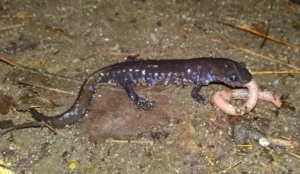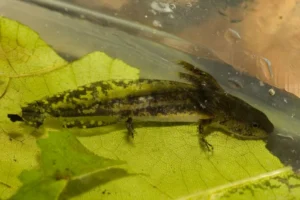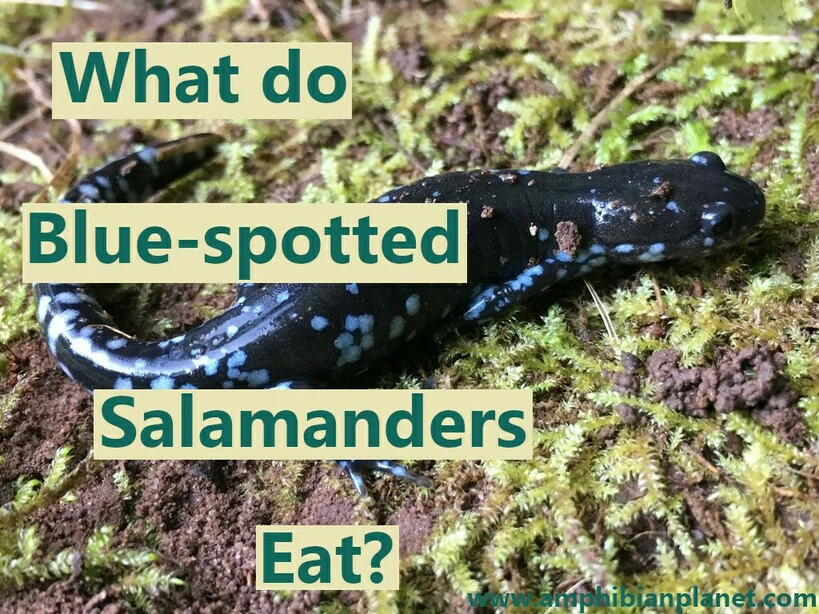Blue-spotted salamanders are colorful amphibians found in parts of the eastern United States and Canada. These salamanders are easily identifiable by the beautiful bluish-white spots and flecks on their bluish-black skin. But what do blue-spotted salamanders eat?
Blue-spotted salamanders are opportunistic carnivores with a very diverse diet. In the wild, they eat worms, snails, slugs, centipedes, spiders, a wide variety of insects, and other invertebrates. In captivity, they can be fed worms, crickets, dubia roaches, grubs, and other soft-bodied insects.
Like most salamanders, blue-spotted salamanders begin their lives as tiny aquatic larvae feeding on zooplankton and other tiny aquatic animals. As they grow, they begin to eat larger prey, such as small insects, tadpoles, and other aquatic larvae.
After a few months, the larvae go through a process known as metamorphosis and leave the water for life on land. On land, their diet shifts to mainly land-based prey such as insects and worms, but they aren’t picky with what they eat.
Almost any prey they can catch and fit into their mouth is on the menu – but they mainly prefer to eat invertebrates.
What Blue-Spotted Salamander Larvae Eat in the Wild
Female blue-spotted salamanders lay eggs in woodland ponds and ditches and attach them to twigs, rocks, or submerged vegetation.
At this stage, the embryos get all their nutrition from the yolk of the egg. It contains enough nutrients to sustain them until they are ready to hatch as larvae, in about one month.

When the larvae hatch, they have well-developed eyes, mouths, external gills, and broad tails – and will feed on:
- Aquatic mites
- Copepods
- Waterfleas and other near-microscopic aquatic invertebrates
As they grow, they can eat larger prey such as
- Small insects
- Aquatic insect larvae (especially mosquito larvae)
- Small worms
- Snails, leeches
Large larvae even feed on small tadpoles, and other smaller salamander larvae, including their own species.
Blue-spotted salamander larvae are aggressive predators. Since blue-spotted salamanders lay eggs in fishless ponds, the larvae are often one of the dominant predators in their ponds.
What Juvenile Blue-Spotted Salamanders Eat in the Wild
After a few weeks, the larvae would have grown enough to slowly begin transforming into adults through a process known as metamorphosis, which prepares them for life on land.
During this process, they lose their gills, develop lungs for breathing air, and their flat tail fin will thicken and become more rounded.
Once this process is fully complete (which takes a few months), the larvae will leave the pond to live on land. At this point, their diet will shift away from aquatic prey and toward terrestrial prey.
 However, since they are not fully grown yet, they can only eat small prey.
However, since they are not fully grown yet, they can only eat small prey.
Wild juvenile blue-spotted salamanders will eat:
- Small worms
- Small slugs, snails
- Small insects and other invertebrates
What Adult Blue-Spotted Salamanders Eat in the Wild
Adult blue-spotted salamanders are fully grown, meaning they have bigger mouths and stronger jaws. They can eat all the food they ate as juveniles, but their larger size allows them to also eat things they did not eat as juveniles.
 They are not very picky eaters and will eat almost prey they can catch and fit into their mouths. However, they generally like to eat soft-bodied invertebrates as they are easier to digest.
They are not very picky eaters and will eat almost prey they can catch and fit into their mouths. However, they generally like to eat soft-bodied invertebrates as they are easier to digest.
Here’s a list of things that will make up an adult blue-spotted salamanders diet in the wild:
- Worms, slugs, snails
- Spiders, centipedes, woodlice
- Grasshoppers, moths, beetles
- Crickets, fruit flies
- Grubs, and a wide variety of other small insects.
In the wild, blue-spotted salamanders spend most of their time hiding under logs, rocks, or leaf litter in their forest habitat. For this reason, most of their diet will be made up of prey that is abundant in that environment.
They will only eat live “moving prey” and will generally ignore dead worms, bugs, or other prey items.
What Adult Blue-Spotted Salamanders Eat In Captivity
Captive blue-spotted salamanders can eat all the food they would eat in the wild. The only reason they have a different diet is that most hobbyists cannot easily obtain the wide variety of prey these salamanders eat in the wild.
So they are limited to only prey items they can purchase or culture on their own.

However, even in captivity, it’s a good idea to keep your blue-spotted salamanders diet as close to its wild diet as possible. This means you have to feed it live prey.
Earthworms seem to be a favorite among many blue-spotted salamander owners. The worms can be dusted and gut-loaded to make them more nutritious (more information on that is below).
Here’s a list of things you can feed a blue-spotted salamander in captivity:
- Nightcrawlers & earthworms (though I do not recommend the red-ringed ones – genera Eisenia and Dendrobaena).
- Crickets, dubia roaches, flightless fruit flies
- Mealworms, wax worms, black soldier fly larvae
- Silkworms, hornworms
Nightcrawlers can make up a majority of their diet. However, the key is a healthy blue-spotted salamander is a varied and nutritious diet, so remember to switch up the food items offered every few feedings.

Again, I DO NOT RECOMMEND red wigglers (Eisenia fetida), because they exude a noxious fluid and are toxic to many animals. Some salamanders will not accept to eat them, and if they do accept them, they may be harmed by the worm’s toxins.
If you want to feed your salamander mealworms, it’s a good idea to only use the ones that have just shed, and still have soft bodies, as the hard exoskeleton of fully-formed mealworms is very hard for many amphibians to digest.
Also, it is important to use the right size of feeder insects. If the insects are too large, your salamander will most likely ignore them and go hungry.
A good rule of thumb is to never give a salamander any insect larger than the distance between its eyes.
Can You Feed a Captive Blue-spotted salamander Wild Bugs?
You could feed your salamander wild-caught bugs. Just be 100% sure they are from a clean area that’s free of pesticides or other chemicals. Avoid feeding them bugs that can sting or bite, such as large spiders, hornets, bees, etc
Still, to be on the safe side, you should only feed your salamander insects that are captive-bred for the live-food industry.
That being said, you can feed your blue-spotted salamander with freshly-dug garden worms if your garden is free of pesticides.
Gut Loading & Nutrient Supplements
In the wild, blue-spotted salamanders get all the vitamins and minerals they need from the wide variety of prey they eat. In captivity, their diet is simplified and limited to only a few things.
In addition, captive-bred feeder insects are often raised on a cost-conscious diet that is meant to help them grow quickly. This means they are not as nutritious as wild insects that eat a wide variety of vitamin and mineral-rich food.
If your salamander is given a low-nutrient diet, it could develop metabolic bone disease which is a fairly common issue in amphibians. It develops as a result of an imbalance of vitamin D3, phosphorous, and calcium.
Amphibians cannot process calcium without vitamin D, which is activated by ultraviolet light. For this reason, it is important to increase the nutritional value of the food you give to your salamander.
This is mainly done in two ways: dusting, and gut loading.
Gut Loading
Gut loading is the process by which feeder insects, (other prey items) are fed nutrient-dense foods at least 48 hrs before they are offered to the salamander. The intention is to pass those nutrients on to the salamander when the insects are eaten.
In this context, you want to give your crickets, or other prey items, foods with lots of nutrients – for example, fresh fruits and vegetables with lots of vitamin C.
After consuming this food, the insects will be much more nutritious and pass the nutrients on to the salamander when they are eaten.
Dusting
Besides gut loading, another way to ensure your blue-spotted salamander gets all the vitamins and minerals it needs is by dusting its food with high-quality powder calcium and vitamin supplements.
Most hobbyists use commercially manufactured supplement powder specifically designed for reptiles and amphibians.
The process is simple:
- First, add a small pinch of supplement powder into a small container such as a cup or an empty cereal container. The powder should only be enough to lightly dust the insects.
- Place one feedings worth of feeder insects in the container
- Gently shake the container so the supplements lightly coat the insects
- Once finished, you can offer the dusted insects to your salamander.
It is important to know what calcium formula is right for your pet, whether it be no D3, low D3, or high D3.
Since blue-spotted salamanders are nocturnal, they are not going to metabolize the D3 from the sun – but will instead absorb it from their diet. For this reason, it’s recommended that you use a calcium supplement that is high in D3.
It’s a good idea to alternate between a calcium a multi-vitamin powder. If you dust with a calcium powder, next time remember to dust with a multi-vitamin powder instead, and vice-versa.
How Much & How Often to Feed Your Blue-Spotted salamander
Generally, adult blue-spotted salamanders will have to be fed about twice a week, while young blue-spotted salamanders will need to be fed every day or two. However, the temperature of the enclosure will determine the frequency of feeding.
If the temperature is 59°F (15°C) or less, your salamander will have a slower metabolism and be less active, so feeding once a week will be enough.
At temperatures of 65°F (18°C) or higher, your salamander will have a much faster metabolism and will need to be fed much more frequently (two times per week).
Regarding how much to feed your blue-spotted salamander, the general rule is to only offer as much as the salamander can eat in a 20-minute feeding session.
For adults, this usually means one nightcrawler or between three and six two-week-old crickets but there is no absolute figure here; so it has to be learned with a bit of experimentation.
Monitor the number of food item items left over after each feeding session. In addition to this, keep an eye on the weight of your salamander to ensure it is not becoming overweight.
How Long Can a Blue-Spotted Salamander Go Without Eating?
Generally, blue-spotted can go for as long as two weeks days without eating, especially if the environmental temperatures are low. However, this isn’t to say you should test the endurance of your salamander.
It is a good idea to offer your blue-spotted salamander food at least once or twice a week.
What Baby Blue-Spotted Salamanders Eat In Captivity
In the wild, blue-spotted salamander larvae are aggressive predators that eat tiny aquatic prey they can catch.
In captivity, blue-spotted salamander larvae should be fed tiny live foods. The appropriate foods will depend on the size and age of the larvae. Newly hatched larvae should be fed newly hatched brine shrimp, daphnia, cyclops .sp, chopped white worms, and chopped tubifex worms.
Be careful when feeding cyclops to very small larvae, as cyclops are known to prey on larval fish – so they could also possibly prey on small salamander larvae.

When the larvae are two to three weeks old, they will be large enough to eat bigger things, such as adult brine shrimp, daphnia, glassworms, whole tubifex worms, black worms, and chopped earthworms.
Once the larvae transform into adults, they can be fed wingless fruit flies, pinhead crickets, and other small live prey. As they get bigger, they will be able to eat larger things.
How to Feed a Blue-Spotted Salamander in Captivity
The easiest way to feed a salamander is to simply dump the food into its enclosure and let the salamander have its fill.
However, some salamanders, especially those that are still getting used to a new place may be shy and reluctant to eat. In this case, you could entice the salamander to eat with the use of some feeding tongs.
Use the tongs to gently hold the food item, then rub it near the nose of the salamander. Once he sees it, he will grab it and do the rest.
Why Isn’t My Blue-Spotted Salamander Eating?
1. It Is Still Getting Used to a New Place or Is Shy
The most common reason a salamander won’t eat is that it is under stress, or still getting used to a new place. This is a very common problem with newly acquired salamanders.
To remedy this, try hand-feeding the frog with the help of feeding tongs/tweezers. Use the tongs to gently hold the prey item, and wiggle it in front of the salamander to entice it to eat.
If this does not work try moving the salamander to a dark room, and leave it alone to relax and settle down for a while. In the wild, blue-spotted salamanders are nocturnal creatures, so they will be more active in the dark.
2. The Prey Item Being Offered Is Too Big
Another reason a salamander may reject food is that the prey item you are offering is just too big. Remember, salamanders do not chew their food, so they will not eat anything they can now swallow whole.
As a general rule, never offer a salamander any prey larger than the distance between its eyes.
3. It Is Not Accustomed to the Food Item Being Offered
Another possible reason a salamander may reject food is that it is not used to eating the food you are offering. Try switching the food item being offered. Most salamanders will readily accept worms or live crickets.
4. The Environmental Temperatures Are Low
Remember, salamanders are ectothermic (cold-blooded animals). When the temperatures are low, they will have a lower rate of metabolism, and be less active, so they won’t have the biggest appetite.
This is perfectly normal, and the salamander will have a much better appetite when the temperatures are warmer.
5. Disease or Parasitic Infection
A more serious reason a salamander would reject food would be due to disease or parasitic infection. Carefully inspect the salamander for any possible signs of infection and contact a veterinarian for further instructions.
Common Feeding Mistakes
There are several mistakes salamander owners make when feeding their pets:
Feeding Dead Insects
Most salamanders are ambush hunters that hunt for live/moving prey, so they won’t even attempt to eat dead insects. For this reason, you should only offer live prey items to your blue-spotted salamanders
Forgetting to Dust or Gut-Load Feeder Insects
As mentioned earlier, commercially bred feeder insects are often low in nutrition. Remember to dust or gut-load all your feeder insects before feeding them to your blue-spotted salamander. This will ensure that your salamander gets all the nutrients it needs and stays strong and healthy.
Not Using a Varied Diet
Different food items have different nutrients. Not giving a salamander a varied diet means it will not get the right variety of nutrients it needs and may end up weak and malnourished.
Switch up the food items offered to the salamander every few feedings so it gets a nutrient-rich diet.
Using the Wrong-Sized Feeder Insects
Salamanders do not chew their food, but rather swallow it whole. Feeding a tiny salamander a disproportionately large insect could lead it to choke.
Never give your blue-spotted salamander anything larger than the distance between its eyes. The bigger the salamander, the larger the prey it will be able to eat.
Feeding Food With a High-Fat Content Too Often
Captive amphibians are not very active animals, so they do not burn off calories. This means giving a blue-spotted salamander high-fat food (such as wax worms) too often may lead to obesity.
Obesity can then lead to many health problems. For this reason, it is important to limit food with a high-fat content to only an occasional treat.
Overfeeding/Underfeeding
Salamanders are voracious feeders so overfeeding them is a real possibility. Overfeeding can lead to obesity which could, in turn, lead to the salamander developing health problems.
Alternatively, underfeeding your salamander means it will go hungry and have poor health.
Frequently Asked Questions (FAQS)
What do baby blue-spotted salamanders eat? Baby blue-spotted salamanders are obligate carnivores and eat aquatic insect larvae (especially mosquito larvae), aquatic mites, copepods, water fleas, and other aquatic invertebrates. As they get bigger, they can eat small insects, small worms, snails, small tadpoles, and other salamander larvae.
Do blue-spotted salamanders eat plants? No, blue-spotted salamanders do not eat plants. They are obligate carnivores which means they only eat animal matter. Their digestive systems are not capable of digesting plant matter, so a plant meal can be fatal for a blue-spotted salamander.
How often do blue-spotted salamanders have to eat? In general, adult blue-spotted salamanders have to eat one to two times per week. However, the temperature will affect the frequency of feeding.
How long can a blue-spotted salamander go without eating? Healthy adult blue-spotted salamanders can go as long as two weeks without food, especially if the environmental temperatures are low. However, in most situations, it’s recommended to feed your blue-spotted salamander one to two times per week.
Image credits: jeffcramer/inaturalist. Frupus/Flickr. Mark Yokoyama/Flickr. Pasquale Paolo Cardo/Flickr. ash163/inaturalist. Ian Jacobs/Flickr. Alexandre Roux/Flickr. kzoebel/inaturalist.


